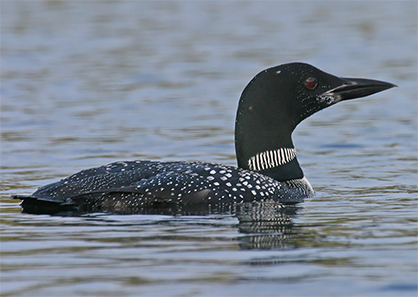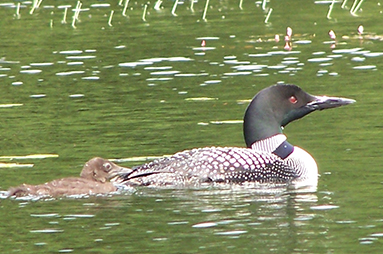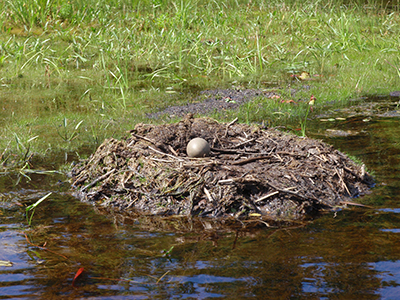
Acid Rain, Mercury and Loons...Oh my!
By John F. Sheehan
June 30, 2014
The Cross-State Air Pollution Rule approved in April by the U.S. Supreme Courts will require another round of reductions in acid rain causing pollutants from the Midwest’s power plants. Over the next few years, the U.S. Environmental Protection Agency (EPA) will order smokestack emissions cuts that appear to be deep enough to halt chronic acid rain damage in the Adirondacks.
Each of us who love the Adirondack Park should celebrate this victory!
 Photo by Larry Master, masterimages.org
Photo by Larry Master, masterimages.orgOne species in the Adirondack Park that will be happy to see the end of acid rain is the loon. Years ago, Professor Rainer Brocke, a now-retired professor and former director of the SUNY College of Environmental Science and Forestry’s Adirondack Wildlife Program, revealed one of his program’s grimmest discoveries.
While studying a loon couple nesting on a remote Adirondack pond, one of Rainer’s students noticed that acid rain had killed-off all the fish in the pond. The loon parents had produced a chick that spring, but had nothing to feed it. Rather than allowing it to starve, the parents took turns flying to another lake to catch fish for their chick while the other stood watch.
This took a lot of time and energy for the loons. And the young loon never learned how to fish by watching its parents. Despite its parents’ efforts, the chick eventually died of starvation anyway. Loons tend to mate long term and  return together to the same nest site every year. So over the next few years, these loons kept returning to the fishless pond, and the same scenario kept playing out as they struggled in vain to feed their growing chicks.
return together to the same nest site every year. So over the next few years, these loons kept returning to the fishless pond, and the same scenario kept playing out as they struggled in vain to feed their growing chicks.
We don’t know why the loons didn’t move to another location where fish were plentiful. Unfortunately, money ran out for the research grant and the college was forced to abandon the study.
This was useful information for the Council. For years, we told this and several other stories in Washington, to illustrate the suffering caused by acid rain. Eventually, the EPA took these messages to heart and proposed the Cross-State Pollution Rule. This is an example of how we at the Council use science to help us advocate for change.
But now we need more information. We know that over time, acid rain has changed the chemistry of our soils and waters, making them more acidic. In lakes and wetlands, acidity also causes a chemical change that unleashes large quantities of toxic metals by breaking down chemical bonds that had prevented them from leaching into the water.
Two of the worst metals released are mercury and aluminum. Like acid rain, they also cause damage to wildlife and people.

Loon egg abandoned by parents
On water bodies where fish are contaminated with mercury, loons are forced to eat and feed their chicks these contaminated fish. Over time, this too can kill their offspring via birth defects and damaged organs. Mercury can also damage the brains of the parents. When this happens, loon parents get confused and may due unnatural things like abandoned their eggs and nest.
What we don’t know is how to eliminate mercury and aluminum from our soils and water bodies faster, so that recovery can occur more quickly.
Aluminum kills spruce and fir trees on our mountain slopes and fish in our lakes and rivers. Calcium in the soil acts as a buffer, but once it’s gone, trees readily absorb aluminum. The aluminum kills them within a few years.

Healthy trout gills. (left)
Trout gills destoyed by aluminum. (right)
In the water, aluminum breaks down gill tissue in fish, causing adult fish to slowly suffocate. It also hardens fish eggs, preventing reproduction. Fish tend to accumulate mercury in their bodies as well and then is absorbed by fish-eating wildlife.
We need to learn about mercury and aluminum. We know how they get released into the environment. And we know how to stop the acid rain that causes it. But we don’t know how long it will take for water bodies to be free of aluminum and fish tainted with mercury.
This is why the Adirondack Council is supporting the studies being done by the NYS Energy Research & Development Authority (NYSERDA) on the impact of the reductions in air pollution that will result from the Cross-State Air Pollution Rule. The Council continues to seek increased funding for the science that helps state and federal officials make good decisions about long-term public policy.
As we wait for acid rain to subside, we will need more research to see the best course of action to better prevent the release of the aluminum that kills fish and trees. Will those measures halt the release of mercury too? Or will we keep fish in lakes longer only to see them grow more heavily contaminated with mercury?
If we intend to advise the NYS Legislature to appropriate additional funds, we need answers to these questions. The Council will continue to monitor and support NYSERDA’s research programs and seek answers to the tough questions that lead to real solutions for the Adirondack Park.
Would you like to comment on what you've read or viewed? We'd love to hear from you. Please click to send us a message.
John F. Sheehan - Born and raised in Troy, NY, John Sheehan is a graduate of Catholic Central High School and the State University at Albany (1985; BA). Before joining the Council's staff in 1990, John was the managing editor of the Malone Evening Telegram, just north of the Adirondack Park. Prior to that, he worked as journalist for the Troy Record, (Schenectady) Daily Gazette, Watertown Daily Times and Newsday.
For the past 20 years, John has been the voice of the Adirondack Council on radio and television, and on the pages of local, regional and national media. Sheehan has overseen the production of two films about the Council (The Adirondack Council, 1992; and, ACID RAIN: A Continuing National Tragedy, 1998), appeared in the independent film Inside the Blue Line (1993) and has produced a series of radio and television public service announcements with entertainers Bonnie Raitt (1994), Natalie Merchant (1997) and brothers/band mates Michael and Kevin Bacon (2009-10).
John is a regular guest lecturer at several New York colleges and universities, including Colgate University, Hobart & William Smith College, Hamilton College, Rensselaer Polytechnic Institute, Union College, Siena College, SUNY Albany, SUNY Binghamton, SUNY College of Environmental Science and Forestry (Syracuse), and SUNY Potsdam. He has also addressed dozens of local organizations including local Rotary and Kiwanis clubs and chambers of commerce, scientific societies and community forums.
In his spare time, John helps to train other not-for-profit organizations' staff in media relations, as well as local farmers in how to promote sustainable agriculture. He also volunteers for the Ujima Journey cultural education project in Albany; the Hamilton Hill Arts Council's annual "Juneteenth" celebration in Schenectady; the Albany Falcons Marching Band and Color Guard; and, the Westland Hills ASA softball league in Albany.
John and his wife Deborah live in Albany and are seasonal residents of the Adirondack Park. Their daughter Hannah attends Albany public schools.




